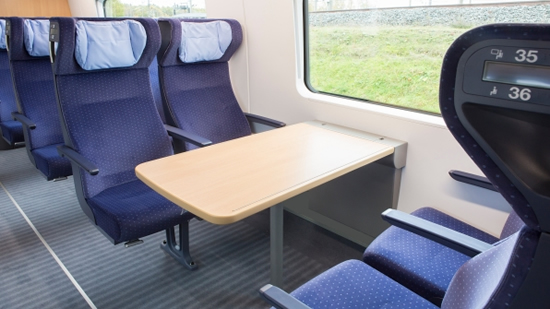A Flexibly Usable Train
Siemens has implemented a radical new concept for the Deutsche Bahn’s ICE 4 high-speed train. All of the cars now operate as independent units and can be combined to form trains with anything from five to 14 cars. The ICE 4 trains will start operating officially in 2017.
On September 14, Siemens and Deutsche Bahn unveiled the first complete ICE 4 train in Berlin. Siemens built the new high-speed train in cooperation with its partner, Bombardier. One of the key new features of the ICE 4 is its drive concept. Siemens developed a powered railcar (or “powercar”) that contains all of the drive technology. Six such powercars are needed to drive a 12-part ICE 4, for example, while the other six cars are not motorized. In the predecessor mode, the ICE 3, three cars together formed a fixed drive unit.
The advantage of the new solution is that each car is a separate entity. This enables trains to be flexibly put together from individual cars, facilitating adaptation to long-term changes in demand. The new technology also prevents drive system defects from causing the entire train to come to a standstill. If a powercar breaks down while the train is traveling, the ICE 4 can continue to its destination driven by the other powercars, albeit at a reduced speed.
Five different types of cars are available for modular composition of the five to 14-part trains: the end unit, the powercar, the center car, the dining car, and the service car (including family areas, wheelchair spaces, etc.). The interiors of the cars can also be very flexibly arranged. The center cars are basically nothing but empty tubes that can be equipped according to the customer’s wishes as either first-class or second-class cars with different seat spacing or adjustable seats on rails.
The Right Train for Every Route
Deutsche Bahn has initially ordered ICE 4 trains with either 12 or seven cars. The seven-part train is 200 meters long, has 456 seats, and includes three powercars enabling it to be driven at speeds of up to 230 km/h. The 12-part variant is 346 meters long and can carry 830 passengers at speeds of up to 250 km/h. Because the modular concept of the ICE 4 enables trains to consist of between five and 14 cars, the trains can be optimally configured for the respective routes, taking factors such as gradients, number of seats, and speed into account.
New Train Control System
In keeping with its modular concept of autonomous individual cars, the ICE 4 will be the first train to feature the brand-new control system Sibas PN from Siemens. This new train control system operates at two levels: the train network for central control functions and a range of independent networks in each individual car. The car networks regulate systems such as the doors, the lights, and the air conditioning. Every time the train starts, these systems log into the train network. If a car is replaced, the new unit automatically integrates itself into the train control system. The train network is housed in the end car. This network also serves as the central interface for calling up all the information relating to the state of the train. Both types of network use a fast Ethernet system with a transmission rate of 100 Mbit per second.
Super-spacious
Each powercar has around 1.6 megawatts (MW) of traction output. The seven-part ICE 4 is accordingly powered by 4.95 MW, while the 12-part train is powered by 9.9 MW. The drive technology of each powercar encompasses four drive motors, the traction cooling system, and the power supply, including transformers and power converters. The lengthening of the superstructure from 25 meters to 28 meters enables all of the components to be installed underneath the floor of the powercar. As a result, a seven-car ICE 4 is exactly as long as an eight-car ICE 3. Because the ICE 4 in this example has one less transition area than the ICE 3, it has much more room, despite having the same length. It also has two fewer swivel trucks, for example. As a result, it weighs less than its predecessor and has fewer components that have to be maintained.
Contact:
Mr. Dr Norbert Aschenbrenner
Editorial Office
Siemens AG
norbert.aschenbrenner@siemens.com
Original Internet Article:
https://www.siemens.com/innovation/en/home/pictures-of-the-future/mobility-and-motors/urban-mobility-a-flexible-high-speed-train.html
Ähnliche Pressemitteilungen im idw



